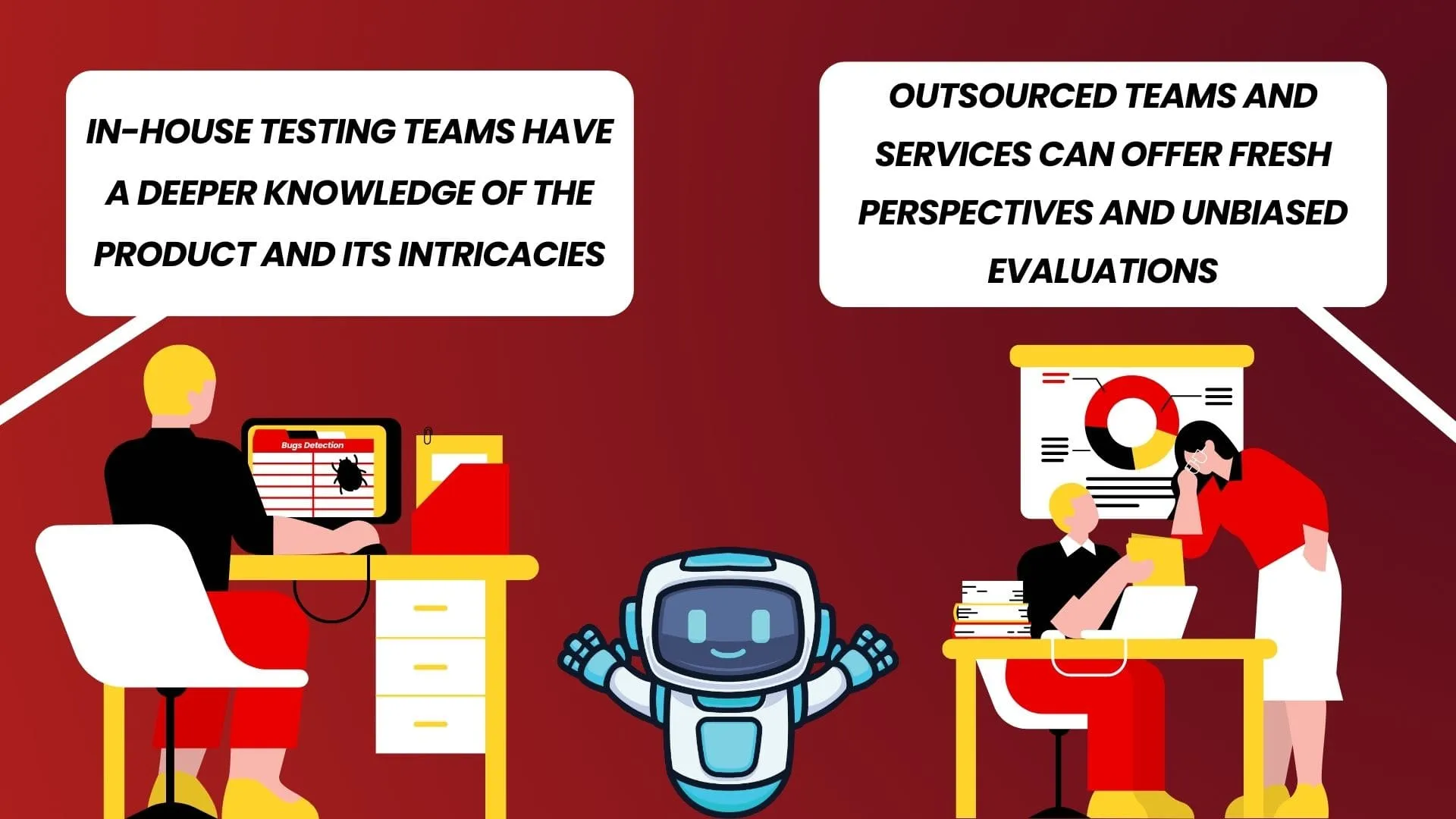🚀 Starting a software development journey involves many obstacles, unknowns, and, yes, expenses. Did you know that the cost of in-house software development occasionally exceeds that of outsourcing, based on the scope and complexity of your project? It is a truth that emphasizes how crucial it is to select the appropriate strategy for software testing.
Allow us to share some crucial insights and helpful lessons with you today so you can direct your software testing company toward more advantageous scenarios and successful results, such as
📌 Navigating the Conflict: Recognizing the differences between outsourcing and in-house work.
📌 Analyzing the compromises: Scalability and cost-effectiveness vs control, confidentiality, and personalization.
📌 Examining a combination strategy: utilizing the greatest aspects of both worlds.
📌 Optimizing Testing Processes: Enhancing the effectiveness and quality of your testing process through optimization.

What is in-house testing?
💻 The software is tested as part of the in-house software testing cycle within the organization's premises, employing its staff, equipment, and resources. Tests of several kinds, including unit, integration, system, regression, and acceptability testing, might be included in this. When software is distributed to customers or users, the aim is to make sure it satisfies quality requirements and performs as intended.
When is in-house testing the better option?
Internal testing is frequently chosen when:
- Confidentiality: Information in the program that is confidential or sensitive cannot be shared with outside parties.
- Control: Complete control over the testing process is required, including over the test environments, timetables, and procedures.
- Customization: Internal testing is more feasible since the specifications are more precise and suited to the company's demands.
- Cost: If the company already has the required resources and experience, doing internal testing could be more economical.
- Security: It might be best to conduct testing inside the company's infrastructure if there are worries about data security or compliance requirements.
- Speed: Since there is no need to coordinate with outside providers, in-house testing is frequently faster than outsourcing, particularly for important or time-sensitive projects.

What is Outsourced Testing?
🧪Software testing Outsourcing:
- Involves assigning external vendors or third-party testing service providers.
- Professional outsourced teams or businesses perform testing tasks on behalf of the company.
🧪 Types of Testing Services:
- Functional testing, performance testing, security testing, usability testing, and more.
- Outsourced testing covers a broad range of testing services.
🧪 Primary Goal:
- Ensure software product quality and dependability.
- Collaboration with external partners leverages their knowledge and resources, aiding in cost reduction and faster time-to-market for software development.
When is outsourced testing the better option?
📀 In a few situations, outsourcing testing may be preferable:
📍Trained Experts
- Outsourcing to specialist vendors brings relevant experience, especially for specific security or performance testing categories.
📍Cost-Effectiveness
- Outsourcing testing can be more cost-effective than building and maintaining an internal infrastructure, especially for one-time tasks.
📍Flexibility and Scalability
- Firms can scale testing activities without hiring or firing staff, enhancing their track record through outsourcing.
📍Concentrate on Core Activities
- Outsourcing testing allows the company to focus on strategic initiatives and core capabilities by freeing internal resources.
📍Access to Newest Technologies and Tools
- Testing service providers can access the latest techniques, technologies, and tools, improving testing efficacy and efficiency.
📍Time Restrictions
- Outsourcing testing speeds up the process and meets project deadlines, especially when facing short time frames for product delivery

Weighing the Pros and Cons of In-House and Outsourced Software Testing
💿 An organization's ability to manage its testing operations more effectively can be enhanced by weighing the benefits and drawbacks of both in-house and outsourced software testing. A summary of each is given below:

Evaluating the hybrid model as a complement, not a replacement
📂 Instead of completely replacing current testing procedures, the hybrid software testing approach, which blends in-house and external testing, can provide several advantages. This is an assessment of its benefits:

🧩Advantages:
- Flexibility: Organizations can modify their testing strategy by project specifications, resource availability, and financial limitations thanks to the hybrid model. They can outsource non-core or specialized testing jobs while utilizing internal expertise for important components.
- Scalability: Organizations can scale their testing activities by adding outside workers to their internal team during peak hours or for specialized testing (such as load testing or security testing).
- Risk Mitigation: By spreading their testing resources, organizations can reduce the risks associated with relying too heavily on one testing strategy. They can use outside expertise to fill in the gaps or deal with resource limitations while controlling the important testing parts.
- Cost Optimization: Businesses may balance quality and cost-efficiency using a hybrid model. They can save expenses without sacrificing quality by investing in internalizing core testing competencies and contracting out non-core work to specialized suppliers.
- Better Time-to-Market: Without overloading their internal teams, companies can expedite testing schedules and enhance the time-to-market for their software releases by utilizing outside testing resources for specific tasks.

🧩 Drawbacks:
- Integration Challenges: When integrating in-house and outsourced testing procedures, coordinating, communicating (avoiding communication barriers), and aligning goals between internal and external teams can be difficult.
- Quality Control: To guarantee that all testing activities align with the organization's quality objectives, meticulous supervision and coordination are needed to maintain uniform quality standards throughout in-house and outsourced testing initiatives.
- Dependency Risk: Relying too much on outside vendors to complete essential testing jobs can lead to dependency and a decrease in internal product knowledge, which may affect the product's long-term sustainability and agility.
- Collaboration and communication: The hybrid model's success depends on efficient coordination and communication between internal teams and outside vendors. Misunderstandings or gaps in communication can cause mistakes, delays, or misplaced expectations.
- Data Security Issues: Encouraging third parties to handle sensitive data creates issues that call for strong contractual agreements, security precautions, and adherence to data protection laws.

Challenges faced by in-house testing teams
⌨️ In-house testing teams deal with daily difficulties, such as organizational dynamics and resource limitations. These are a few typical difficulties:
- Resource Restrictions
- Tight budgets, personnel shortages, and inadequate infrastructure can limit internal testing teams.
- These limitations may result in reduced test coverage, slower testing cycles, and compromised quality.
- Skill Gaps
- Difficulty in assembling and retaining competent testing teams with knowledge of various methods, tools, and technologies.
- Skills deficiencies can lead to inaccuracies, inefficiencies, and suboptimal test results.
- Time Constraints
- Internal testing teams often face deadlines, especially in Agile or fast-paced development environments.
- Time constraints may lead to rushed and less comprehensive testing, increasing the risk of missing important details.
- Regression Testing
- Managing regression testing can be challenging for internal teams, especially in large and complex projects.
- Careful planning and automation are necessary to ensure thorough regression coverage amid time and resource constraints.
- Test Environment Management
- Creating test environments that accurately replicate production settings can be challenging.
- Inconsistent or unstable testing environments may lead to unreliable test results and delays in defect identification.
- Collaboration and Communication
- Effective collaboration and communication between testing teams and stakeholders are crucial for successful outcomes.
- Ineffective communication can lead to misunderstandings, delays in issue resolution, and alignment problems

Examples of In-House Testing commonly conducted by Internal Testing Teams
🖨 The following are a few instances of internal testing that is frequently carried out by teams within an organization:
- Functional Testing
- Internal teams verify program compliance with requirements by testing individual features, user interfaces, APIs, and integrations.
- Regression testing
- Ensures software updates or modifications don't negatively impact existing features.
- This process helps maintain product stability and functionality, benefiting developers and project managers by preventing unintended changes.
- Integration Testing
- Tests integration points between software modules, components, or systems for smooth communication and interoperability.
- Confirms interface compliance, message delivery, and data sharing.
- Performance Testing
- Evaluates software functionality, stability, scalability, and responsiveness to changing loads.
- Identifies performance bottlenecks and maximizes system resources through load, stress, and scalability testing.

- Security Testing
- Internal teams assess software security by identifying flaws, vulnerabilities, and risks.
- Conduct penetration testing, vulnerability scanning, and security code reviews to reduce risks and safeguard data.
- Usability Testing
- Internal testers evaluate program usability and user experience from the end user's perspective.
- Collect input on navigation flows, interfaces, and general usability to ensure user-friendliness and meet expectations.
- Compatibility testing
- Internal teams ensure program functionality across various hardware, operating systems, browsers, and platforms.
- Test for compatibility issues, rendering inconsistencies, and cross-platform compatibility for widespread accessibility.
- Accessibility Testing
- Internal testers assess program usability for impaired people, ensuring compliance with accessibility guidelines like WCAG.
- Test keyboard navigation, screen readers, and alternate input techniques to ensure inclusion.
- Localization Testing
- Internal teams ensure program suitability for users in various locations and linguistic contexts.
- Verify language support, date/time formats, currency symbols, and cultural norms for correct localization.
- Automated Testing
- Internal testers develop and manage automated test scripts and frameworks to expedite testing cycles and simplify operations.
- Include automated functional, regression, and unit tests to enhance reliability and efficiency.

What are some best practices for managing an in-house testing team?
🔍A supportive work environment, good procedures, strong leadership, and clear communication are necessary to manage an internal testing team. The following are recommended guidelines for overseeing an internal testing team:
👉🏻Establish Specific Goals and Objectives:
- Clearly define the testing team's goals, expectations, and responsibilities in alignment with the organization's quality and business objectives.
- Ensure clarity on duties, responsibilities, and performance expectations among team members.
👉🏻Create a Skilled and Diverse Team:
- Recruit exceptional testers with diverse experiences, backgrounds, and skill sets.
- Foster a culture of continuous learning, career growth, and knowledge sharing to enhance team capabilities.
👉🏻Apply Efficient Tools and Procedures:
- Define and implement effective testing methodologies, procedures, and tools to optimize productivity.
- Utilize test management systems, automation tools, and collaboration platforms for increased efficiency.
👉🏻Set clear priorities:
- Encourage transparent and cooperative communication between the testing team and stakeholders.
- Schedule regular meetings, status reports, and feedback sessions to ensure alignment and clarity.

Improving your testing approach: A comparative analysis of in-house and outsourced models
🪄 Comparing and contrasting in-house and outsourced models can help you better understand their advantages and disadvantages and enhance your testing strategy. This is how you should go about doing this analysis:
- Establish Primary Objectives
- To begin, specify the main aims and objectives you hope to accomplish with your testing strategy. Some examples are cost savings, direct control, quality control, scalability, flexibility, and time-to-market.
- Determine Needs and Limitations
- Examine your company's unique testing needs, limitations, and priorities. Consider the project's complexity, staffing availability, subject knowledge, budget, and strategic goals.
- Analyze Your In-House Testing Team's Capabilities and Resources
- Consider the infrastructure, knowledge, and experience of your dedicated team.
- Assess the efficiency of the procedures, techniques, and instruments you currently employ for internal testing.
- The advantages include more control, subject-matter expertise, and alignment with internal goals and procedures.
- Determine your flaws, including possible bias, limitations on scalability, and resource constraints.
- Assess the model of outsourced testing
- Investigate and evaluate possible outsourcing providers according to their qualifications, history, standing, and experience.
- Consider the advantages of outsourcing, including cost savings, flexibility, scalability, and access to specialist talents (from the pool of talent).
- Consider the possible negatives, such as control loss, difficulty communicating, dependency risk, and quality issues.
- Conduct a comparative analysis
- Based on the goals and specifications you have specified, weigh the advantages and disadvantages of the internal and external testing models.
- Examine communication, control, scalability, flexibility, cost savings, and risk management.
- Consider the possible effects on project schedules, resource distribution, and general business results.

Final Note
✨️ Thus, by contrasting in-house and outsourced models, this article examines the best method for software testing. Each model's advantages and disadvantages are examined, and a hybrid strategy builds on each one's advantages. Intellectual property rights, commonly outsourced testing services, legal compliance, KPIs for assessing internal teams, and long-term testing decisions are important factors to consider.
In the end, knowing these elements aids companies in refining their testing plan for increased effectiveness and quality.
.webp)
People Also Ask
👉🏻How do legal requirements for compliance affect the decision between in-house and external testing?
Because internal testing has greater control over sensitive data and adheres to regulatory norms, it may be preferred by legal requirements for compliance.
👉🏻What are the key performance indicators (KPIs) for evaluating the success of in-house testing teams?
The effectiveness of internal testing teams is measured by key performance indicators (KPIs) such as time-to-market, regression rates, test coverage, and defect density.
👉🏻What types of testing services are commonly outsourced?
Performance, security, usability, and localization testing are frequently outsourced testing services.
👉🏻What are the long-term implications of choosing in-house testing over outsourcing?
If in-house testing is chosen versus outsourcing, there may be more long-term control, expert retention, and alignment with company goals; however, there may also be a bigger infrastructure and resource investment required.
👉🏻What are the implications of intellectual property rights in outsourced testing?
Protecting sensitive information in outsourced testing requires strong contractual agreements, data security protocols, and unambiguous ownership of testing artifacts. These are some of the implications of intellectual property rights.


-p-500.webp)


%201.webp)

